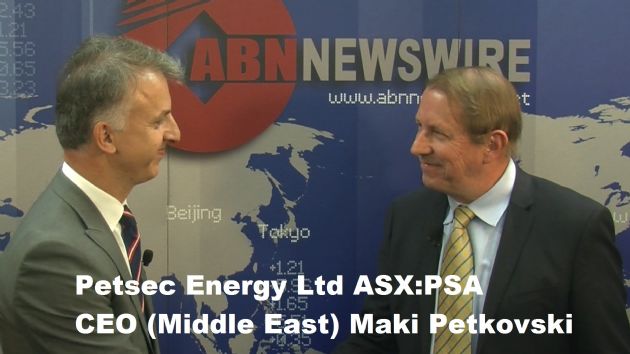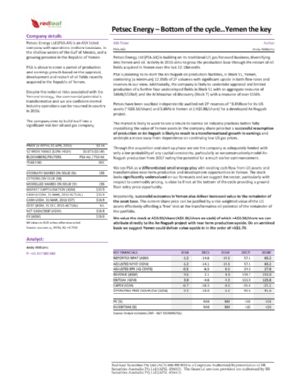Sydney, Aug 1, 2006 AEST (ABN Newswire) - Petsec Energy Ltd (ASX: PSA)(PNK: PSJEY) announce that the following is a copy of a further update released today from the operator of the well; ROC Oil Company Limited (ASX: ROC)(PNK:RCILF):
KEY POINTS
- Preliminary appraisal results from the second sidetrack well drilled at the recent Wei 6-12S-1 oil discovery in Block 22/12 in the Beibu Gulf, offshore China, range from encouraging to as expected.
- Encouragingly, four oil-filled sands, representing a total of 22 metres gross and 16 metres net oil pay, were encountered in the Upper Sand Package, more than 45 metres downdip from the original well and outside structural closure as presently mapped. Two of these sands are not present in the discovery well.
- Information from the two sidetrack wells, taken in conjunction with the latest analysis of data from the discovery well, confirms that the Upper Sand Package is not a single reservoir system but is made up of as many as seven distinct oil sands, all with different oil-water contacts and separate oil - and in two cases, oil and gas - columns. In six cases individual oil columns are inferred to range in height from 40 metres to 60 metres while one column, in a five metre sand, is inferred to be possibly as much as 180 metres.
- As expected, the Middle and Lower Sand packages were encountered between 100 metres and 230 metres downdip from the discovery well and are therefore water-wet. Drill and pressure data from the two sidetracks and the discovery well established a 60 metre oil column in the Middle Sand package and infer a possible 105 metre oil column in the Lower Sand Package updip from the second sidetrack.
- A deep stratigraphic exploration target proved to be a reservoir quality sand sequence without hydrocarbons.
1. OPERATIONS
Since the last Stock Exchange Release on 26 July 2006 regarding the Wei 6-12S-1 exploration well in Block 22/12, Beibu Gulf, offshore China, the second sidetrack hole, Wei 6-12S-1Sb ("1Sb") has drilled to Total Depth of 2,950 metres below Rotary Table.
As at midnight (local time) on 31 July 2006, logging operations were almost complete.
2. SIDETRACK DRILLING PROGRAMME RATIONALE
Following the discovery of 95 metres of net hydrocarbon pay, including 80.5 metres net oil pay, within a 477 metre gross reservoir sequence drilled by the Wei 6-12S-1 exploration well, the Block 22/12, Joint Venture immediately embarked on a two month appraisal drilling programme. As a result, two sidetracks were drilled from the original discovery well, both of which achieved their main objective: the acceleration of data gathering so as to provide maximum information with regard to determining the field's commercial potential.
3. OVERALL OBJECTIVES AND RESULTS
The primary objective of the first sidetrack, Wei 6-12S-1a ("1Sa"), was to obtain core data from the main reservoirs encountered in the discovery well. To achieve this objective 1Sa was located about 50 metres to the east of the original hole. Five cores were cut with 100% recovery, representing 79 metres of reservoir section and additional logs and pressure data were also acquired.
The main aim of the second sidetrack well, 1Sb, was to define more precisely the vertical and lateral extent of the oil accumulations in the Upper Sand Package by penetrating that sequence more than 45 metres downdip from the discovery well. As a result of drilling 1Sb, as many as seven separate reservoir sands, all with different oil-water contacts and separate oil - and in two cases, oil and gas - columns, are now recognised in the Upper Sand Package. In six cases individual oil columns are inferred to range in height from 40 metres to 60 metres, with one column, in a five metre sand, inferred to be possibly as much as 180 metres. This contrasts with the provisional interpretation of the initial data obtained from the discovery well that suggested that the sands seen in the Upper Sand Package might be part of a single main reservoir with a common oil water contact (see CEO's Comments in Section 5).
A secondary objective of 1Sb was to test a relatively deep, stratigraphic exploration target, not present in the discovery well, which proved to be a reservoir quality sand without oil shows.
In order to achieve these dual objectives 1Sb's trajectory was designed so that it would encounter the oil reservoirs in the Middle and Lower Sand Packages drilled by the discovery well respectively 100 metres to 230 metres downdip from that well and therefore, below their respective oil-water contacts; this proved to be the case.
The reservoir quality and continuity of the three sand packages are broadly consistent over the ca 400 metres lateral distance represented by the three reservoir penetrations. The overall section thickens downdip and additional sands, not seen in the discovery well, are present off-structure.
4. PRELIMINARY DETAILED RESULTS
1Sa and 1Sb have provided drill, log, sample and pressure data which will require months to analyse properly. However, a preliminary evaluation of the results of the three wells drilled to date provides useful insights into the nature and extent of the field. Specifically:
4.1 Upper Sand package
Although it penetrated the top of the sequence some 48 metres downdip from the discovery well, 1Sb drilled four oil sands within the Upper Sand Package none of which has an oil-water contact. These sands, which collectively represent 22 metres of gross pay and 16 metres of net oil pay, are detailed below in order of increasing depth:
- The highest oil sand in 1Sb, has a gross pay of 5.5 metres, 100% net. It equates to a one metre sand in the discovery well where it occurs above and separate from, the higher of two gas sands reported in that well. This oil sand was not specifically referred to in the 17 May 2006 Stock Exchange release that first detailed the discovery because it was considered to be immaterial. The fact that the sand has thickened downdip and an oil-water contact has not been drilled by the downdip sidetrack is encouraging. The minimum oil column inferred for this sand is 48 metres.
- The higher of two gas sands in the discovery well is also present in 1Sb where it has a gross pay of six metres and a net pay of 5.5 metres. However, in 1Sb, this sand is oil-filled, thereby confirming the presence of a down dip oil leg associated with the highest gas sand in the discovery well. The minimum inferred oil column for this sand is 53 metres. It is further inferred that this oil leg underlies a minimum 39 metre gas column part of which was penetrated by the updip discovery well.
- An oil sand, with six metres of gross pay and about three metres of net pay, occurs within the Upper Sand Package but is absent from the updip discovery well. There is no oil-water contact in this sand in 1Sb and the inferred oil column for the sand is 60 metres.
- The deepest oil sand encountered in 1Sb has a gross pay of 4.5 metres thick and a net pay of about two metres. This sand is also present in the discovery well where it provided a pressure reading that was considered to be possibly spurious because its implied a very long downdip oil column. This pressure information has been essentially replicated in both sidetracks thereby increasing the possibility that the oil column in this sand may be in the order of 180 metres, although further work needs to be done to more precisely evaluate this scenario.
Three sands which contain hydrocarbons in the Upper Sand Package in the discovery well are present as water-wet sands in 1Sb. Inferred vertical oil columns for these sands, up dip from 1Sb, range from 40 metres to about 60 metres.
In two cases, the inferred oil-water contacts are broadly coincident with a seismic anomaly which suggests that such features may prove to be useful tools with regard to delineating oil and gas accumulations in and around the field.
All of the oil columns seen in the Upper Sand Package penetrated by the three wells drilled to date appear to extend below structural closure as currently mapped. Unless there is a significant unrecognized seismic velocity anomaly to the east of the three wells it would seem that there is a stratigraphic component to the trapping mechanism at the level of the Upper Sand Package. There is no seismic velocity anomaly in the immediate vicinity of the three wells drilled to date.
4.2 Middle Sand Package
This is the main oil sand drilled by the discovery well. In that well, the interval has a gross thickness of 60 metres, of which 31 metres is net oil pay. The discovery well drilled through an oil-water contact - the only one penetrated by any of the three wells so far drilled in the field - which appears to be just below structural closure as currently mapped. Because 1Sb was designed to intersect the Middle Sand Package 106 metres downdip from the discovery well, it was expected to be water-bearing and that proved to be the case.
Encouragingly, the first sidetrack, 1Sa, recovered clean oil from near the base of the main reservoir in this Middle Sand Package which had previously been considered to be a likely transition zone. The discovery well established a 60 metres oil column in this sand updip from 1Sb.
4.3 Lower Sand Package
Although the discovery well did not drill through an oil-water contact in this sand package pressure data suggested that 1Sb would be too far (>200 metres) downdip to encounter oil in the equivalent sands and that proved to be the case. However, 1Sa cored part of this interval and a preliminary review of these data suggests that the reservoir quality is better than the test flow rate of 1,720 BOPD might indicate and that the test result was constrained by formation damage. Pressure data gathered from 1Sb infer that there is potentially a 105 metre oil column in this sand updip from that well. The lower part of this oil column appears to be below structural closure as presently mapped.
5. CEO'S COMMENTS.
Commenting on the drilling results to date ROC's Chief executive Officer, John Doran, stated that:
Overall, this appraisal programme has provided encouraging results and no unpleasant surprises.
The recognition of multiple oil reservoirs in the Upper Sand Package with substantial individual oil columns is a significant step forward in our understanding of the size and nature of the field.
One of the challenges of the discovery is explaining in non-technical terms what is going on in a field which has a variety of different sands, the vast majority of which contain oil, spread out over hundreds of metres vertically within a trap that, although associated with a structure that is well defined by 3D seismic, seems to have a significant stratigraphic component, the exact extent of which is unknown. This is, however, a welcome challenge compared to explaining a dry hole.
As a result of three months of continuous operations on a well that was expected to be have been finished within a few weeks if it had been dry, the Joint Venture has been left with three important reservoir penetrations, a wealth of subsurface data that requires detailed analysis and strong evidence that this newly discovered oil accumulation may extend beyond structural closure as presently mapped.
If the field had a single reservoir and was confined by structural closure, assessing its true nature would have been quicker and simpler. In all probability, we would now have a fairly good idea as to the ultimate size of the accumulation. The fact that the field seems to be at least partly defined by stratigraphic elements means that although the data gathered to date is expected to confirm the commerciality of the discovery, more appraisal and/or development drilling will be required before accurate recoverable reserve numbers can be provided for the field as a whole. This is not to say that the field will necessarily prove to be huge, just that it is likely to be bigger than if it was limited by structural closure.
A lack of specific recoverable reserve figures can be frustrating for shareholders and potential investors but, in the long run, it is considered better to admit that such precise numbers are beyond our technical reach at this particular moment rather than generate figures which may inadvertently mislead and cause a reserve downgrade in the future.
Although exact numbers for recoverable reserves are not yet available it is possible to provide a tentative sense of direction as to the likely order of magnitude of in-place oil and the commercial potential of the field. The balance of current probabilities suggests that the oil in-place is likely to be measured in terms of many tens of millions of barrels and, if this proves to be the case, a commercial development would be anticipated."
6. JOINT VENTURE COMPOSITION
The Block 22/12 Joint Venture comprises*:
Roc Oil (China) Company 40% and OperatorHorizon Oil Limited 30%Petsec Energy Ltd 25%Oil Australia Pty Ltd** 5%
*The China National Offshore Oil Company ("CNOOC") is entitled to participate up to a 51% funding equity level in any commercial development within Block 22/12.
** A subsidiary of First Australian Resources
Petsec Energy Ltd is an independent oil and gas exploration and production company listed on the Australian Stock Exchange. Its focus of operations is on gas in the shallow waters of the Gulf of Mexico and onshore Louisiana Gulf Coast region of the USA, and on oil in the shallow waters of the Beibu Gulf off the south coast of China.
About Petsec Energy Ltd
 Petsec Energy Ltd (ASX:PSA) (OTCMKTS:PSJEY) is an independent oil and gas exploration and production company listed on the Australian Stock Exchange. It has operations in the shallow waters of the Gulf of Mexico and state waters of the Louisiana Gulf Coast region of the USA, and exploration activities in the Gulf Coast onshore and bay areas of Texas and Louisiana, USA and Yemen.
Petsec Energy Ltd (ASX:PSA) (OTCMKTS:PSJEY) is an independent oil and gas exploration and production company listed on the Australian Stock Exchange. It has operations in the shallow waters of the Gulf of Mexico and state waters of the Louisiana Gulf Coast region of the USA, and exploration activities in the Gulf Coast onshore and bay areas of Texas and Louisiana, USA and Yemen.
![abnnewswire.com]()
Related Companies
Social Media
Share this Article
 Petsec Energy Ltd (ASX:PSA) (OTCMKTS:PSJEY) is an independent oil and gas exploration and production company listed on the Australian Stock Exchange. It has operations in the shallow waters of the Gulf of Mexico and state waters of the Louisiana Gulf Coast region of the USA, and exploration activities in the Gulf Coast onshore and bay areas of Texas and Louisiana, USA and Yemen.
Petsec Energy Ltd (ASX:PSA) (OTCMKTS:PSJEY) is an independent oil and gas exploration and production company listed on the Australian Stock Exchange. It has operations in the shallow waters of the Gulf of Mexico and state waters of the Louisiana Gulf Coast region of the USA, and exploration activities in the Gulf Coast onshore and bay areas of Texas and Louisiana, USA and Yemen.















